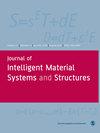Development and performance evaluation of a wheel-type cantilevered piezoelectric rotational energy harvester via an unfixed exciting magnet
IF 2.2
3区 材料科学
Q3 MATERIALS SCIENCE, MULTIDISCIPLINARY
Journal of Intelligent Material Systems and Structures
Pub Date : 2023-06-02
DOI:10.1177/1045389x231177806
引用次数: 0
Abstract
A wheel-type cantilevered piezoelectric rotational energy harvester (wheel-type PREH) via an unfixed exciting magnet was presented to harvest energy from rotational motion without or far away from a fixed support. To verify the structural feasibility and figure out the effect of rolling exciting magnet and excited magnet on the dynamic characteristics and power generation performance of the wheel-type PREH, the theoretical analysis, simulation, fabrication and experimental testing were performed. The results showed that the performance of the wheel-type PREH depended on the rotary speeds, proof mass and piezo-cantilever mass, number of exciting magnets, cylindrical sleeve materials and so on. When other parameters were constant, there were multiple optimal rotary speeds for the maximal amplitude-ratio, output voltage, electrical energy and output power to achieve peak. Besides, the total number of voltage crests per second did not change with rotary speed. There was a constant optimal resistance load for the wheel-type PREH at different rotary speeds to achieve maximal power. The PREH prototype could yield a maximum output power of 0.74 mW at 767 r/min with optimal load resistance of 215 kΩ and 40 different color LEDs in parallel and a low power light strip could be lighted by wheel-type PREH.一种轮式悬臂式非固定励磁压电旋转能量采集器的研制与性能评价
提出了一种基于非固定激励磁体的轮式悬臂式压电旋转能量采集器(wheel-type PREH),用于在无固定支撑或远离固定支撑的情况下从旋转运动中获取能量。为验证结构的可行性,研究滚动励磁和励磁对轮式PREH动力特性和发电性能的影响,进行了理论分析、仿真、制造和实验测试。结果表明,轮式PREH的性能与转速、验证质量、压电悬臂质量、激励磁体数量、圆柱套材料等因素有关。在其他参数一定的情况下,最大幅值比、输出电压、电能和输出功率均有多个最优转速达到峰值。此外,每秒电压峰值总数不随转速的变化而变化。在不同转速下,轮式PREH具有恒定的最优阻力负荷以获得最大功率。PREH原型可以在767 r/min的速度下产生0.74 mW的最大输出功率,最佳负载电阻为215 kΩ, 40个不同颜色的led并联,并可以通过轮式PREH点亮低功率灯条。
本文章由计算机程序翻译,如有差异,请以英文原文为准。
求助全文
约1分钟内获得全文
求助全文
来源期刊
CiteScore
5.40
自引率
11.10%
发文量
126
审稿时长
4.7 months
期刊介绍:
The Journal of Intelligent Materials Systems and Structures is an international peer-reviewed journal that publishes the highest quality original research reporting the results of experimental or theoretical work on any aspect of intelligent materials systems and/or structures research also called smart structure, smart materials, active materials, adaptive structures and adaptive materials.

 求助内容:
求助内容: 应助结果提醒方式:
应助结果提醒方式:


